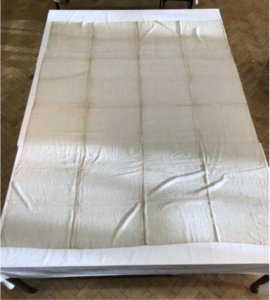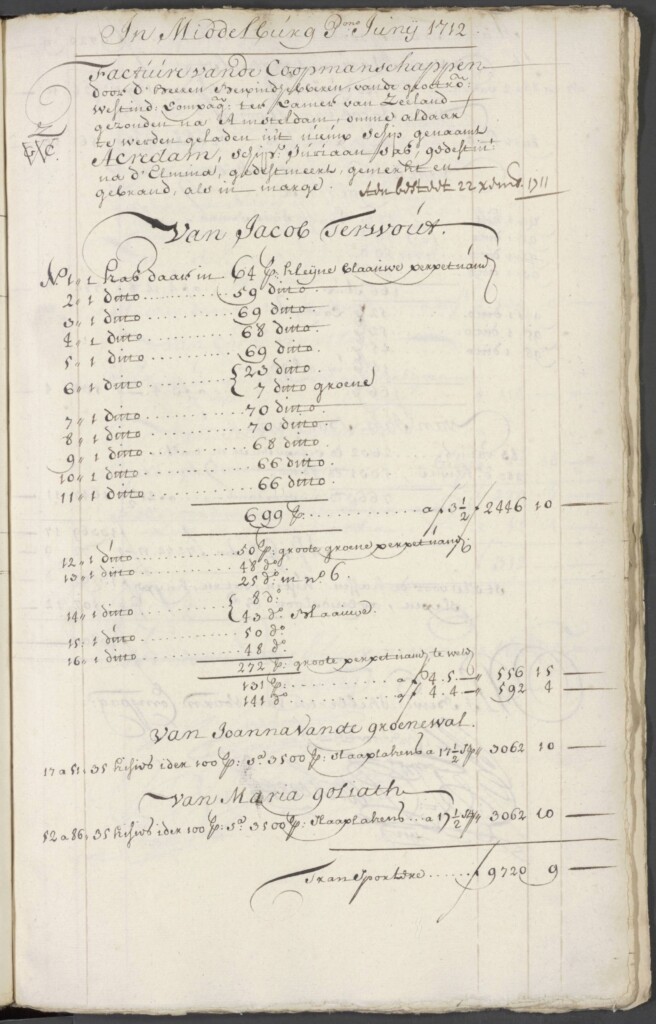Definition
Name Variants
With Qualifiers
slaplagen [Common Spelling Variation, Danish], sheets [Common Spelling Variation, English], bed sheets [Common Spelling Variation]Textiles, Modifiers, and Values
Choose a textile from the dropdown list on the upper left. Select modifier(s) for your selected textile, if any. The bar graph will generate visualizations that reflect your selections. X- and y-axis variables can also be changed.
A note about modifiers: The modifier dropdown list will include only those modifiers that relate to the selected textile. Choose OR to see results that match any of the selected modifiers. Choose AND to see results that match all of the selected modifiers. You can select more than one modifier in each field.
Essay
Slaaplakens, or bedsheets, were popular trade items on all major trading posts on the west coast of Africa. Made from linen, these bedsheets were sometimes described as “old,” meaning second-hand, in secondary literature. Slaaplakens were carried on West India Company ships only (they did not circulate in Asia), and constituted a large portion of the imported textiles shipped to each of the three trading regions in Africa (by piece, not necessarily by yardage).
Slaaplakens ranged in price from 14 to 30 ½ stuivers per sheet, with the majority priced between 17 and 18 ¼ stuivers. Slaaplakens are rarely listed with any kind of descriptive modifier—so, for example, between 1700 and 1724 there are only two instances in which slaaplakens have been described as “printed,” which resulted in a higher price of 30 ½ stuivers (an outlier by all accounts), nor are they described as a particular color during this period. Slaaplakens are sometimes described as “big” or “small,” but this is rare and does not seem to affect the price. Some travel accounts from the 17th and 18th centuries describe slaaplakens purchased by African consumers as “old,” meaning second hand, but the modifier “old” has only occurred in three instances in our data set and is not accompanied by a significant change of price. According to travel accounts African consumers preferred Dutch slaaplakens to English or Danish linen sheets—as will be discussed below—but all kinds were circulating.
Since patterned slaaplakens seem to be the exception rather than the rule and since we have yet to find any evidence of dyed slaaplakens, we are operating under the assumption that most bedsheets shipped to West African on West India Company ships at this time would have looked similar to this linen bedsheet from the Victoria & Albert Museum, which consists of two separate pieces of linen joined together by bobbin lace.

Unlike other types of trade textiles from this period—the majority of slaaplakens were provided to the WIC by women merchants, such as Maria Goliath and Joanna van de Groenewald, who were two—among many—women textile traders (see the bottom two entries on the document below). More than three times the number of slaaplakens were sold by women than men, which suggests that the selling of bed sheets offered women living in the Dutch Republic the opportunity to generate household income. Of the more than six hundred thousand slaaplakens sold to the WIC between 1700 and 1725, 60% percent of them were sold by women—and likely many more.[1]

But these documents tell us nothing about how these textiles were used in an African context. For this, we are in large part dependent on European travel accounts, which are culturally biased at best and must be interpreted cautiously. For example, Pieter de Marees, the former WIC employee who wrote the 1602 text, Description of the Gold Coast of Guinea, notes a preference for “Holland linen” (though not slaaplakens specifically), which was sold in a market in Elmina and which local consumers cut “into strips which are only about the width of one hand and use these instead of girdles around their bodies.”[2] This comment suggests that they were cutting linen to approximate the dimensions of textiles produced on an African strip loom, which was widespread at this time and which measured about seven to nine inches in width.[3] While De Marees may have been referring to bolts of cut linen, later writers are more specific. Samuel Brun, a German barber-surgeon under the employ of the WIC in the second decade of the seventeenth century, wrote of his 1617 voyage to Fort Nassau in Moree (Mori) in current-day Ghana in his 1624 book. Of a local wedding ceremony, he describes “a white garment, which may consist of an old linen sheet that they have obtained from us and consider to be an elegant garment.”[4] Danish West India Company employee Ludewig Ferdinand Rømer, who lived in and around the Danish headquarters at Christiansborg Castle, in current-day Ghana from 1739 to 1749, writes in his 1760 text, A Reliable Account of the Coast of Guinea, that used Dutch slaaplakens were preferred to Danish ones, even though they were so thin that “you could almost blow to shreds, as you might a spider’s web.” A informant tells him that local women used them for menstrual rags.[5]
Footnotes
[1] This figure does not include husband-and-wife teams and those labeled as “various suppliers,” which would bring the percentage up much higher.
[2] Pieter de Marees, Description and Historical Account of the Gold Kingdom of Guinea, trans. Albert. van Dantzig and Adam. Jones (trans.), (Oxford and /New York: Oxford University Press, 1987), 51.
[3] On the West African strip loom, see History, Design, and Craft in West African Strip-Woven Cloth: Papers Presented at a Symposium Organized by the National Museum of African Art, Smithsonian Institution (Washington, DC: National Museum of African Art, 1988); Peggy Stoltz Gilfoy, Patterns of Life.: West African Strip-Weaving Traditions (Washington, DC: Smithsonian Institution Press, 1975); Patricia Fiske, The Lamb Collection of West African Narrow Strip Weaving (Washington, DC: The Textile Museum, 1975).
[4] Adam Jones, German Sources for West African History, 1599–-1669, Studien zur Kulturkunde 66 (Wiesbaden: Franz Steiner Verlag, 1983), 86–87.
[5] Ludewig Ferdinand Rømer, A Reliable Account of the Coast of Guinea (1760), ed. and trans. Selena Axelrod Winsnes (Oxford University Press, 2000), 191–192.





